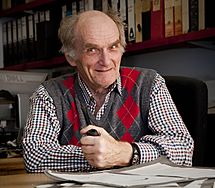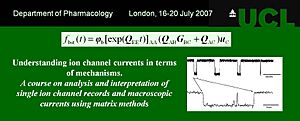David Colquhoun facts for kids
Quick facts for kids
David Colquhoun
FRS MAE
|
|
|---|---|

David Colquhoun in 2013
|
|
| Born | 19 July 1936 Birkenhead, Cheshire, England
|
| Alma mater |
|
| Known for |
|
| Awards | Humboldt Prize (1990) |
| Scientific career | |
| Fields | |
| Institutions | |
| Thesis | The characterisation and adsorption of sensitising antibodies (1965) |
| Doctoral advisor | W.L.M. Perry W.E. Brocklehurst |
David Colquhoun, born on July 19, 1936, is a British scientist who studies how medicines affect the body (this is called pharmacology). He worked at University College London (UCL) for many years. He is known for his work on how tiny "doors" in our cells, called ion channels, open and close. These channels are super important for how our bodies work.
He also held an important teaching position at UCL from 1985 to 2004. In 1985, he became a Fellow of the Royal Society, which is a big honor for scientists. David Colquhoun also runs a website called DC's Improbable Science. On this site, he shares his thoughts on things that claim to be science but aren't, like some alternative medicine ideas.
Contents
Early Life and Education
David Colquhoun was born in Birkenhead, UK, on July 19, 1936. He went to Birkenhead School and Liverpool Technical College. At first, he worked as an apprentice pharmacist, but he wasn't happy with it. This made him want to go into scientific research instead.
He earned his first degree (BSc) in pharmacology from the University of Leeds. Then, he went on to get his PhD from the University of Edinburgh. For his PhD, he studied how certain parts of our immune system, called immunoglobulins, attach to lung tissue. During his studies, he became very interested in random processes and statistics. These interests would become very important in his future research.
After finishing his PhD, Colquhoun did more research at UCL from 1964 to 1969. He also wrote a book about statistics during this time. Later, he worked at Yale University and the University of Southampton. He returned to UCL in 1979 and has been there ever since.
Exploring How Cells Work
David Colquhoun's research focused on understanding how tiny molecules interact to make ion channels open and close. He also studied what controls the speed of signals between nerve cells, called synaptic events.
A special technique called the patch clamp was invented by Erwin Neher and Bert Sakmann. This technique allowed scientists to watch and record the individual openings and closings of single ion channels. However, these recordings are random, like rolling dice. Colquhoun worked with a statistician named Alan G. Hawkes to create a special statistical method. This method helped them understand the data and test ideas about how ion channels work.
He also runs a website called OneMol.org.uk with Lucia Sivilotti. This website shares information about UCL's research on single ion channels and how they use statistical inference to understand their findings.
Understanding Ion Channels
In 1977, Colquhoun and Hawkes made a prediction. They thought that ion channels would open in short bursts, not just one at a time. This idea was proven true in experiments with Bert Sakmann in 1981. This important discovery helped solve a long-standing problem in pharmacology. It allowed scientists to measure how strongly a drug attaches to a cell (affinity) and how well it works (efficacy).
Their 1985 paper was later called a "classic" by The Journal of Physiology. In 1982, Colquhoun and Hawkes published another paper about these bursts of activity. They created a formula to describe how long these bursts would last. This formula was even put on a mug for a course designed to teach the math needed for it!
It became clear that the length of these bursts controlled how quickly signals faded in the brain. However, the exact relationship wasn't fully understood until 1998.
Seeing Short Events
Even though the main ideas about single channel behavior were figured out by 1982, it was hard to use them in real experiments. This was because recording equipment couldn't detect very short events, those shorter than about 20 microseconds. When these short events were missed, it made the openings and closings seem longer than they actually were.
To use a method called "maximum likelihood," scientists needed to know the true length of the events they were seeing. In 1990, Hawkes and Jalali found an exact solution to this problem. This solution became practical after Hawkes and Jalali found a simpler way to use it in 1992. This work led to a computer program called HJCFIT, which helped scientists analyze their data. The measurements of these "apparent" open and shut times are often called HJC distributions, named after Hawkes, Jalali, and Colquhoun.
Different Shut States
Early research often assumed that a cell's receptor (the part that receives signals) had only two states: open or shut. But when scientists studied the glycine receptor, they found something new. They discovered an "intermediate shut state" – a kind of in-between state before the channel fully opened. This extra state was also found in the nicotinic acetylcholine receptor.
In 2008, scientists found that some drugs, called "partial agonists," didn't work as well as others. This wasn't because they were bad at opening the channel itself. Instead, it was because they had trouble getting the receptor to move from its resting state to this intermediate shut state. The actual step of going from shut to open was similar for both strong and partial drugs. This new understanding changed how scientists thought about how these drugs work.
Understanding Statistics Better
After his work on single ion channels, Colquhoun continued to be interested in statistical inference. This is about how we draw conclusions from data. In 2014, he wrote a paper about how people sometimes misunderstand "p-values." A p-value is a number that helps scientists decide if their results are likely due to chance.
His paper helped with a big discussion in science about how to make sure research results are reliable. He pointed out that even a very small p-value (like 0.001) doesn't always mean a strong discovery. If the idea being tested was very unlikely to begin with, even a small p-value could still mean there's an 8% chance of a false positive.
He suggested that scientists should not just say if something is "significant" or "non-significant." Instead, they should also talk about the "false positive risk." This helps everyone understand how likely it is that a result is just a fluke.
Awards and Honors
David Colquhoun was elected a Fellow of the Royal Society (FRS) in 1985. This is one of the highest honors for a scientist in the UK. He also received the Humboldt Prize in 1990, which is a prestigious international award.
Personal Life
In 1976, David Colquhoun married Margaret Ann Boultwood. They have a son and two granddaughters.
Outside of his scientific work, Colquhoun has enjoyed many hobbies. He has been involved in boxing, flying small airplanes, and sailing. He also enjoys long-distance running, including 10 km races, half-marathons, and marathons. In 1988, he completed the London marathon in 3 hours and 57 minutes. For his 65th birthday in 2001, he went on a long walk across the Alps, from Germany to Italy.


